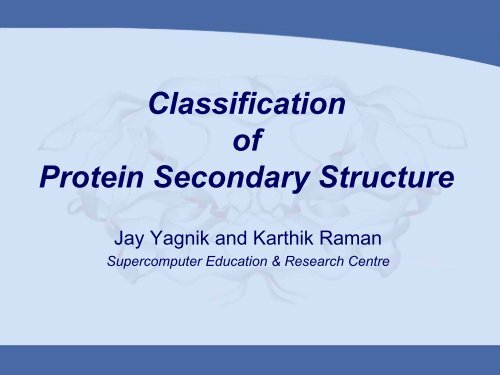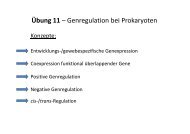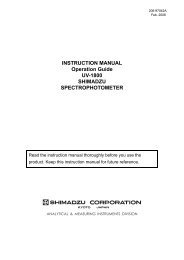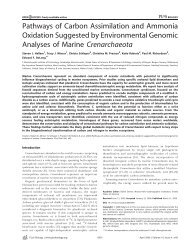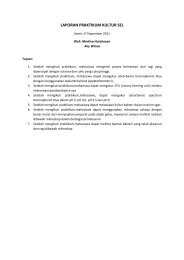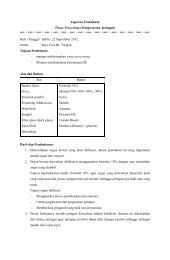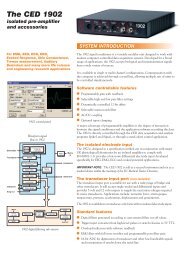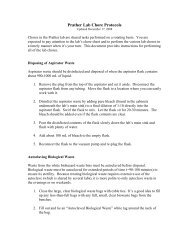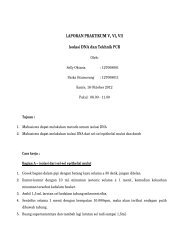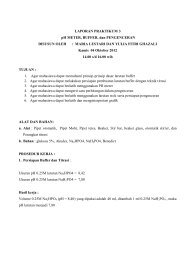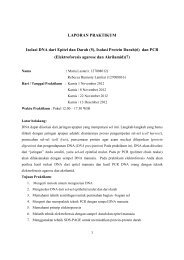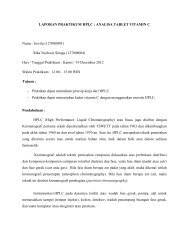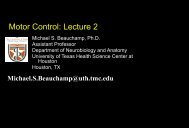Classification of Protein Secondary Structure - OpenWetWare
Classification of Protein Secondary Structure - OpenWetWare
Classification of Protein Secondary Structure - OpenWetWare
Create successful ePaper yourself
Turn your PDF publications into a flip-book with our unique Google optimized e-Paper software.
<strong>Classification</strong><br />
<strong>of</strong><br />
<strong>Protein</strong> <strong>Secondary</strong> <strong>Structure</strong><br />
Jay Yagnik and Karthik Raman<br />
Supercomputer Education & Research Centre
<strong>Protein</strong> <strong>Structure</strong><br />
Primary – Sequence <strong>of</strong> amino acids<br />
<strong>Secondary</strong> – Local conformation <strong>of</strong> chain<br />
Tertiary – Global 3-D structure<br />
Quaternary – Associations <strong>of</strong> polypeptide chains
Elements <strong>of</strong> <strong>Secondary</strong><br />
α-helix<br />
<strong>Structure</strong><br />
β-sheets
Typical proteins<br />
How to classify?
Why classify proteins?<br />
• <strong>Structure</strong> conserved more than<br />
sequence<br />
• <strong>Structure</strong> is basis for function<br />
• Order vast amounts <strong>of</strong> structural data<br />
• Common philosophy <strong>of</strong> studying groups<br />
rather than individuals
Strategies for classification<br />
• <strong>Structure</strong> alignment and comparison<br />
– DALI, VAST, CE<br />
• Feature Extraction<br />
– COFE, FastMap, Knot theoretic methods<br />
• Probabilistic Methods<br />
– PRIDE
Structural <strong>Classification</strong><br />
Databases<br />
• SCOP (Structural <strong>Classification</strong> <strong>of</strong><br />
<strong>Protein</strong>s)<br />
• CATH (Class Architecture Homologous<br />
Superfamilies)
SCOP<br />
Structural <strong>Classification</strong> <strong>of</strong> <strong>Protein</strong>s<br />
• Fully Manually Curated<br />
• Hierarchy<br />
– Family<br />
– Superfamily<br />
– Common fold<br />
–Class<br />
· All-α · All-β<br />
· α / β · α + β<br />
· multi-domain
CATH<br />
• Class<br />
• Architecture<br />
• Topology<br />
• Homologous superfamily<br />
• Sequence family
<strong>Structure</strong> Comparison &<br />
Alignment<br />
• Superposition <strong>of</strong> 3-D structures<br />
• Closely examine SSEs<br />
• Distances between C-α and C-β atoms<br />
• Significance <strong>of</strong> similarity must be<br />
evaluated<br />
• e. g.: FSSP, VAST, CE
FSSP<br />
Families <strong>of</strong> Structurally Similar <strong>Protein</strong>s<br />
• Fully automated<br />
• Unlike CATH/SCOP<br />
• Z-score > 2.0 is significant<br />
• Uses DALI algorithm<br />
• Z-score is useful for automatic<br />
classification
Distance Matrix Alignment<br />
(DALI)<br />
• <strong>Structure</strong>s represented as 2D arrays <strong>of</strong><br />
C-α distances<br />
• Similar structures have similar interresidue<br />
distances<br />
• <strong>Secondary</strong> structure similarity inferred<br />
from diagonal overlaps<br />
• Off-diagonal similarities correspond to<br />
tertiary structure
Vector Alignment Search Tool<br />
• Represents structures as SSEs<br />
• Topology inferred from type,<br />
directionality and connectivity <strong>of</strong> SSEs<br />
• p-value for statistical significance <strong>of</strong><br />
similarity
Combinatorial Extension<br />
• Comparison <strong>of</strong> octameric fragments –<br />
Aligned Fragment Pairs<br />
• Based on local geometry rather than<br />
global orientation <strong>of</strong> SSEs or topology<br />
• Possible combinations <strong>of</strong> AFPs are<br />
extended to give an optimal alignment
Demerits <strong>of</strong> Structural<br />
Comparison & Alignment<br />
• Rely on pair-wise comparison<br />
• Expensive and slow<br />
• Triangular inequality not satisfied
Feature Extraction based<br />
approaches<br />
• Distance Preserving<br />
– FastMap<br />
– COFE<br />
• Absolute Descriptors
Distance Preserving<br />
Methods<br />
• Use the distance given by alignment<br />
algorithms and try to come up with<br />
features which behave the same way in<br />
the distance framework<br />
• Distance calculation expensive, so try to<br />
optimize on number <strong>of</strong> distance<br />
evaluations
COMDS (Complex Object Multi-<br />
Dimensional Scaling)<br />
• Distances between objects are defined<br />
by some non-Euclidean method<br />
• Objects are complex (not part <strong>of</strong><br />
Euclidean space)<br />
• Distance evaluation is expensive
FastMap<br />
• Take points with longest distance<br />
• Project all others on that line and take<br />
the distances as the feature value<br />
• Factor the distance out and repeat
COFE<br />
(Complex Object Feature Extraction)<br />
• Chooses sets <strong>of</strong> points called Reference<br />
sets<br />
• Features are the distance <strong>of</strong> the closest<br />
point in the reference set.<br />
• No. <strong>of</strong> features = No. <strong>of</strong> reference sets.
COFE vs FastMap<br />
• Asymptotically similar performance<br />
• But with small number <strong>of</strong> features COFE<br />
performs better<br />
• Number <strong>of</strong> distance evaluations are<br />
significantly less in COFE due to<br />
possibility <strong>of</strong> optimisations
Absolute Descriptors<br />
• Vassiliev Knot Invariants<br />
• Distance Histograms
Knot Theory
Knot Diagrams
Knot Invariants<br />
• Average Crossing Number (First order<br />
Vassiliev invariant)<br />
• Minimum crossing number<br />
• Unknotting number
Vassiliev Knot Invariants<br />
• Set <strong>of</strong> mathematical descriptors based<br />
on the number <strong>of</strong> crossings seen in knot<br />
diagrams<br />
• Average Crossing Number is a first order<br />
Vassiliev Knot Invariant<br />
• Independent <strong>of</strong> rotation,scale, translation<br />
• Depend only on the geometric shape <strong>of</strong><br />
the structure
Application to <strong>Protein</strong><br />
<strong>Classification</strong><br />
• Fain and Rogen applied it on CATH.<br />
– Used Invariants up to order 3.<br />
– Extracted features from CATH in < 2hrs.<br />
– Equivalent to 400 million pair wise<br />
alignments…….a workstation would take<br />
several hundred years to do this.<br />
– 96% classification accuracy.
Distance Histograms<br />
• Histograms <strong>of</strong> the inter C-α distances using<br />
some window length<br />
• PRIDE (Probability <strong>of</strong> Identity)<br />
– Uses histograms from window lengths <strong>of</strong> 3-30<br />
– Compares them using average histogram as<br />
the expected histogram and applying chisquare<br />
goodness <strong>of</strong> fit test.


